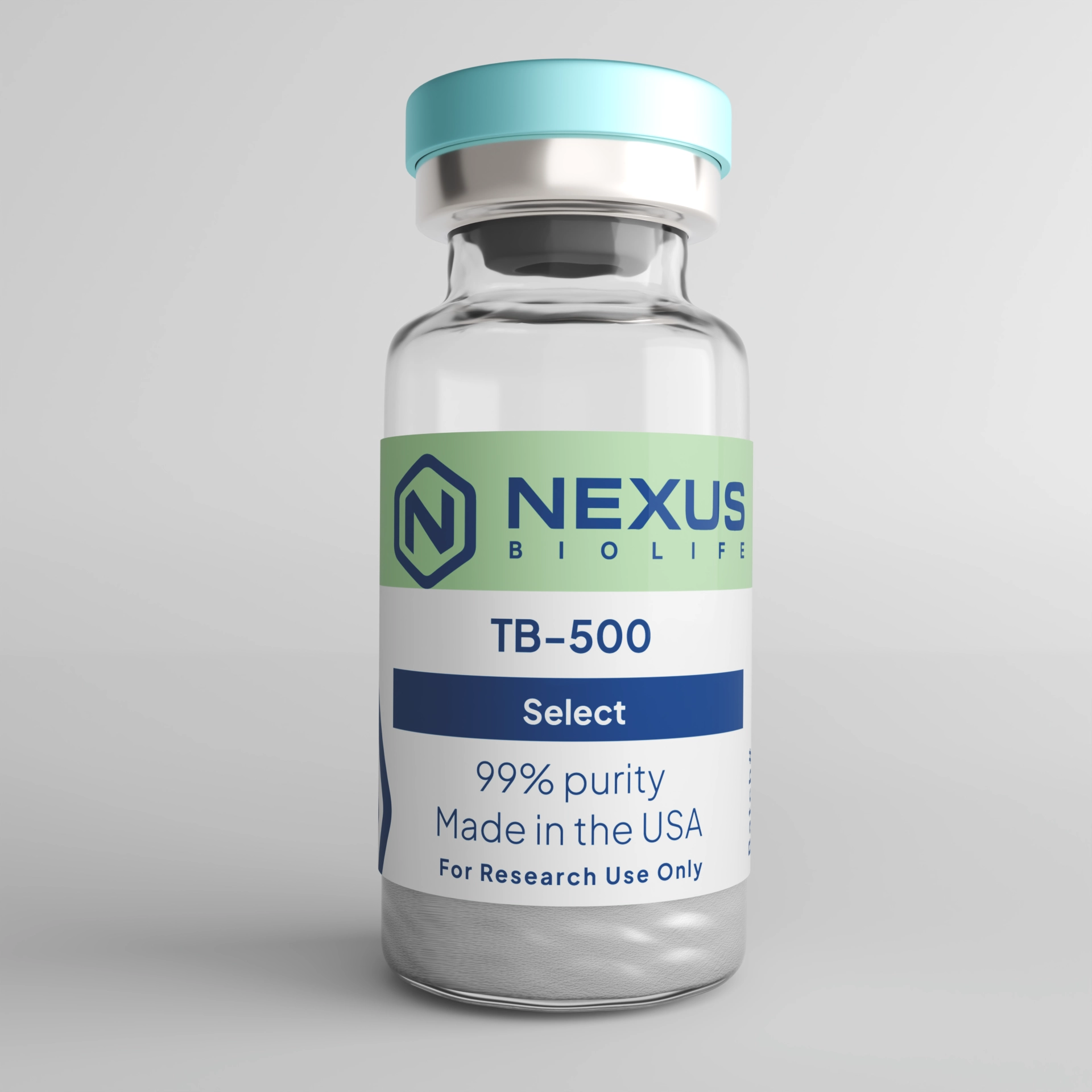
TB-500 is a peptide renowned for its role in scientific inquiry. This compound is synthesized with an impressive 99% purity. It offers researchers a reliable option for various laboratory applications. TB-500 is designated solely for research and development purposes.

TB-500 consists of a 43-amino-acid sequence: Ser-Asp-Lys-Pro-Asp-Met-Ala-Glu-Ile-Glu-Lys-Phe-Asp-Lys-Ser-Lys-Leu-Lys-Lys-Thr-Glu-Thr-Gln-Glu-Lys-Asn-Pro-Leu-Pro-Ser-Lys-Glu-Thr-Ile-Glu-Gln-Glu-Lys-Gln-Ala-Gly-Glu-Ser, with a molecular weight of approximately 4963 Da and an isoelectric point around 5.1. Its structure includes a central actin-binding domain (LKKTETQ) responsible for its primary functions, along with regions that confer stability and resistance to proteolytic degradation. This peptide is highly conserved across species, highlighting its evolutionary importance in cellular maintenance.
In laboratory settings, TB-500 is typically provided as a lyophilized powder with purity exceeding 98%, as verified by HPLC and mass spectrometry. It exhibits excellent solubility in aqueous buffers at neutral pH, facilitating easy reconstitution for assays. Our quality assurance process emphasizes transparency, with each batch tested for consistency to ensure reliable performance in your experiments.
TB-500, also known as Thymosin Beta-4 (Tβ4), is a naturally occurring 43-amino-acid peptide that plays a crucial role in cellular processes such as actin sequestration, tissue repair, and angiogenesis in experimental models. Isolated from thymic tissue, this peptide mimics the body's innate mechanisms for wound healing and inflammation modulation, making it an excellent tool for in-vitro investigations into regenerative biology and metabolic responses. As with all our peptides, TB-500 is supplied strictly for research purposes and in-vitro use only—not for human consumption or any therapeutic applications.
TB-500 primarily acts by binding and sequestering G-actin, preventing its polymerization into F-actin and thereby promoting cell motility, migration, and cytoskeletal reorganization essential for tissue repair. It also stimulates angiogenesis through upregulation of vascular endothelial growth factor (VEGF) and enhancement of endothelial cell viability, while reducing inflammation by inhibiting NF-κB activation and cytokine release such as TNF-α and IL-1β. In models of injury, TB-500's N-terminal fragment Ac-SDKP contributes to anti-fibrotic effects by modulating pathways like TGF-β/SMAD signaling.
Furthermore, TB-500 supports neuroprotection by promoting remyelination and reducing oxidative stress, potentially via JNK signaling modulation. We appreciate how TB-500's multifaceted actions provide a logical framework for studying cellular adaptation—it's like a conductor orchestrating repair at the molecular level, and we're happy to help you design assays that highlight these processes.
In summary, TB-500 embodies a powerful regenerative peptide, facilitating in-vitro explorations of actin dynamics, angiogenesis, and tissue repair through its actin-binding and anti-inflammatory mechanisms. Its broad applicability in modeling healing processes underscores our enthusiasm for peptides that bridge fundamental science with practical insights. Strictly for research use, TB-500 aligns with our values of quality and education in empowering your work. Let's foster those connections and push boundaries together, one experiment at a time.
TB-500's regenerative properties make it a versatile peptide for in-vitro and ex-vivo research in wound healing, cardiovascular repair, and neuropathy. In dermal models, it has been used to accelerate epithelial migration and collagen deposition, demonstrating enhanced wound closure in diabetic or aged tissue simulations. Cardiovascular studies employ TB-500 to investigate myocardial recovery, where it promotes progenitor cell recruitment and reduces fibrosis post-infarction.
In neurological assays, TB-500 supports explorations of peripheral nerve regeneration, alleviating conduction deficits in diabetic neuropathy models through anti-inflammatory and myelin-promoting effects. Ophthalmic research highlights its potential in dry eye or corneal healing, where it decreases inflammation and stimulates repair pathways. Additional applications include antimicrobial biomaterial development, leveraging its metabolites for antiviral coatings. We suggest pairing TB-500 with injury-mimicking stressors in your protocols for deeper insights, and our team is ready with approachable advice to refine your approach.
To optimize TB-500 for your research, store the lyophilized powder at -20°C or below in a dry, light-protected environment to prevent degradation. Reconstitute with sterile bacteriostatic water or a neutral buffer to concentrations of 1-5 mg/mL, using gentle swirling to avoid foaming that could disrupt its structure. Once prepared, aliquot solutions and store at 2-8°C for short-term use or freeze for longer periods, minimizing freeze-thaw cycles to maintain bioactivity.
Our stability testing confirms resilience under these conditions, but always check for clarity and pH before assays. If you have questions about compatibility with your media or equipment, we're your reliable source for logical, evidence-based recommendations.
TB-500, also known as Thymosin Beta-4 (Tβ4), is a naturally occurring 43-amino-acid peptide that plays a crucial role in cellular processes such as actin sequestration, tissue repair, and angiogenesis in experimental models. Isolated from thymic tissue, this peptide mimics the body's innate mechanisms for wound healing and inflammation modulation, making it an excellent tool for in-vitro investigations into regenerative biology and metabolic responses. As with all our peptides, TB-500 is supplied strictly for research purposes and in-vitro use only—not for human consumption or any therapeutic applications.
TB-500 primarily acts by binding and sequestering G-actin, preventing its polymerization into F-actin and thereby promoting cell motility, migration, and cytoskeletal reorganization essential for tissue repair. It also stimulates angiogenesis through upregulation of vascular endothelial growth factor (VEGF) and enhancement of endothelial cell viability, while reducing inflammation by inhibiting NF-κB activation and cytokine release such as TNF-α and IL-1β. In models of injury, TB-500's N-terminal fragment Ac-SDKP contributes to anti-fibrotic effects by modulating pathways like TGF-β/SMAD signaling.
Furthermore, TB-500 supports neuroprotection by promoting remyelination and reducing oxidative stress, potentially via JNK signaling modulation. We appreciate how TB-500's multifaceted actions provide a logical framework for studying cellular adaptation—it's like a conductor orchestrating repair at the molecular level, and we're happy to help you design assays that highlight these processes.
In summary, TB-500 embodies a powerful regenerative peptide, facilitating in-vitro explorations of actin dynamics, angiogenesis, and tissue repair through its actin-binding and anti-inflammatory mechanisms. Its broad applicability in modeling healing processes underscores our enthusiasm for peptides that bridge fundamental science with practical insights. Strictly for research use, TB-500 aligns with our values of quality and education in empowering your work. Let's foster those connections and push boundaries together, one experiment at a time.
TB-500 consists of a 43-amino-acid sequence: Ser-Asp-Lys-Pro-Asp-Met-Ala-Glu-Ile-Glu-Lys-Phe-Asp-Lys-Ser-Lys-Leu-Lys-Lys-Thr-Glu-Thr-Gln-Glu-Lys-Asn-Pro-Leu-Pro-Ser-Lys-Glu-Thr-Ile-Glu-Gln-Glu-Lys-Gln-Ala-Gly-Glu-Ser, with a molecular weight of approximately 4963 Da and an isoelectric point around 5.1. Its structure includes a central actin-binding domain (LKKTETQ) responsible for its primary functions, along with regions that confer stability and resistance to proteolytic degradation. This peptide is highly conserved across species, highlighting its evolutionary importance in cellular maintenance.
In laboratory settings, TB-500 is typically provided as a lyophilized powder with purity exceeding 98%, as verified by HPLC and mass spectrometry. It exhibits excellent solubility in aqueous buffers at neutral pH, facilitating easy reconstitution for assays. Our quality assurance process emphasizes transparency, with each batch tested for consistency to ensure reliable performance in your experiments.

TB-500's regenerative properties make it a versatile peptide for in-vitro and ex-vivo research in wound healing, cardiovascular repair, and neuropathy. In dermal models, it has been used to accelerate epithelial migration and collagen deposition, demonstrating enhanced wound closure in diabetic or aged tissue simulations. Cardiovascular studies employ TB-500 to investigate myocardial recovery, where it promotes progenitor cell recruitment and reduces fibrosis post-infarction.
In neurological assays, TB-500 supports explorations of peripheral nerve regeneration, alleviating conduction deficits in diabetic neuropathy models through anti-inflammatory and myelin-promoting effects. Ophthalmic research highlights its potential in dry eye or corneal healing, where it decreases inflammation and stimulates repair pathways. Additional applications include antimicrobial biomaterial development, leveraging its metabolites for antiviral coatings. We suggest pairing TB-500 with injury-mimicking stressors in your protocols for deeper insights, and our team is ready with approachable advice to refine your approach.
To optimize TB-500 for your research, store the lyophilized powder at -20°C or below in a dry, light-protected environment to prevent degradation. Reconstitute with sterile bacteriostatic water or a neutral buffer to concentrations of 1-5 mg/mL, using gentle swirling to avoid foaming that could disrupt its structure. Once prepared, aliquot solutions and store at 2-8°C for short-term use or freeze for longer periods, minimizing freeze-thaw cycles to maintain bioactivity.
Our stability testing confirms resilience under these conditions, but always check for clarity and pH before assays. If you have questions about compatibility with your media or equipment, we're your reliable source for logical, evidence-based recommendations.
